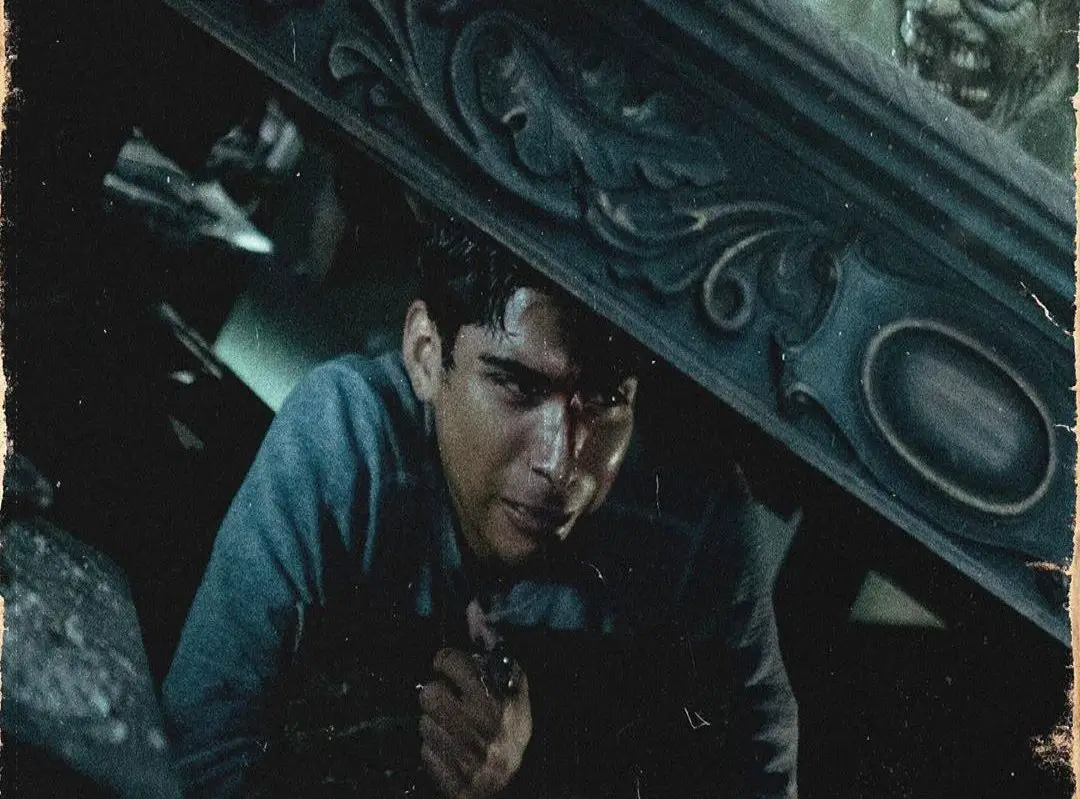“Harold.” “The Big Toe.” “Dough-Ty Walker.” For a few generations of brave readers, these and dozens of other stories from Alvin Schwartz’s trilogy of “Scary Stories to Tell in the Dark” hold a special place as an early encounter with the spooky and spine-tingling. A selection of the most memorable of these stories serves as the basis for Andre Ovredal’s new adaptation, woven together by a tale that Schwartz could have written himself.
The story opens on Halloween night, 1968, in the quiet town of Mill Valley. Stella Nicholls (Zoe Margaret Colletti) and her friends Auggie (Gabriel Rush) and Chuck (Austin Zajur) are getting a bit old for trick-or-treating, and this year the trio plans to pull a prank on the group of sadistic jocks who terrorize kids every Halloween.
When the prank goes a little too well, the three are forced to flee from the enraged jocks, eventually taking shelter in a stranger’s car at the local drive-in. The car’s owner is an out-of-towner named Ramon (Michael Garza), who’s about Stella’s age and shares her affinity for all things spooky. The two hit it off, and Ramon eagerly agrees when Stella invites him to tour the local haunted house.
The decrepit mansion once belonged to the Bellows, the wealthy family whose mill helped to establish Mill Valley. The story goes that the Bellows’ youngest daughter, Sarah, was tormented and kept in the basement, and eventually turned to the dark arts. The children who heard her stories whispered through the walls of the house mysteriously died shortly after, and supposedly those bold enough to request a story while in the house could still get one.
Of course, Stella and Ramon find Sara’s basement room and her fabled book of stories. And, of course, Stella asks for a story. Nothing seems to happen, and the group soon heads home. But when new stories begin to appear in the book, featuring those who were in the Bellows’ mansion Halloween night, it’s clear that something has been awakened. As the group of friends begin to get picked off, the rest race to find an answer, or else become another chapter in Sarah’s sinister book.
“Scary Stories to Tell in the Dark” easily could have been a loosely stitched together anthology, in the vein of movies like the “V/H/S” series, and the film’s writers deserve praise for creating a coherent plot and compelling characters in which to frame Schwartz’s stories.
It’s easy to root for Stella and her crew, and they never feel like simple vehicles for delivering the frights that inspired the movie. Auggie and Chuck, as the bickering, teasing pair of middle school friends, particularly stand out, and the comic relief they provide consistently works.
Where the movie most shines, however, is in the design and execution of its scares. The creativity and sense of timing Ovredal and his team demonstrate in bringing Schwartz’s stories to life never fails to impress. The creatures that star in many of these stories are meticulously reimagined in the movie, in ways that are grotesque and hair-raising.
https://www.instagram.com/p/B01MwdDFlGh/?utm_source=ig_web_copy_link
Most memorable is the film’s adaption of the story “The Dream,” featuring a lumbering, obese woman who pursues one character through hospital halls drenched in red light. The scene is a masterclass in pacing and camera work, as the woman appears in every hall the character turns down, always a few paces closer.
Acclaimed horror auteur Guillermo del Toro has a screenwriting credit on “Scary Stories to Tell in the Dark,” and his influence is evident in the film’s tone. Some scenes deftly blend the frightening and the fantastical, like in the movie’s recreation of the classic story “Harold.” In the film’s version, the tale ends with a character transforming into a scarecrow, with straw forcing its way up his throat and from between his fingers.
There’s also a strain of political commentary in “Scary Stories to Tell in the Dark” that del Toro might be responsible for, given his tendency to use horror to such ends in the past. Outside of Mill Valley and the supernatural powers being visited upon it, the Vietnam War is raging, and Richard Nixon is being elected president. There’s never much doubt about the stance the film takes toward these events.
In the opening scene, there’s a shot of some pro-Nixon posters that have been vandalized with swastikas, and later someone wonders how they can trust a candidate nicknamed Tricky Dick. It’s eventually revealed that Ramon is running from the draft, afraid of dying in the war like his brother. Viewers might expect some realization of the burgeoning romance between he and Stella after the two finally manage to stop Sarah, but instead the following scene shows Ramon getting on a bus, bound for the Army.
The resolution of the supernatural horror that dominates the movie is disrupted by a bigger, real world horror that the two teenagers are powerless over. The real boogeyman is perhaps Nixon, who lurks on television screens and campaign posters.
The movie does have a few extraneous bits, and while they don’t dampen the scares, it’s still difficult to see what they bring to the story. The plotline of Stella’s home life, which was thrown into disarray when her mother left, attempts to teach a moral lesson that ultimately isn’t necessary for the film’s resolution. The issue is addressed sporadically throughout the movie, usually through conversations between Stella and her father, a character kept just distant enough to never feel like a true part of the story.
The ambiguity of the movie’s ending, which extends beyond Ramon and Stella’s relationship, is also a touch dissatisfying. Auggie and Chuck, who were claimed by Sarah’s book, have yet to be returned, and Stella explains that she’s dedicated herself to finding them. The conclusion leaves plenty of room for a sequel, a somewhat frustrating possibility given the typical success rate of horror franchises.
https://www.instagram.com/p/By8G6IBFwDy/?utm_source=ig_web_copy_link
Overall, however, “Scary Stories to Tell in the Dark” is a fun, imaginative flick. The film also deserves credit for packing in so many genuine scares while still managing to slide in with a PG-13 rating. With its wisecracking and fearless cast of teens, the movie could easily become a staple of middle school slumber parties for years to come. But it still has plenty to offer an older audience, whether they grew up reading Schwartz’s books, or just appreciate some well-crafted frights.
















